“Exhilarating and Breathtaking” Eve Bushman Covers Riesling in Germany’s Mosel Region
I found myself describing the experience as both exhilarating and breathtaking, and these two words have now taken on a new meaning for me, probably forever. Raimund added to my thoughts when he said that here, we “always sit in the green.”

Have you been to the Middle Mosel, aka Mittelmosel, wine region of Germany? I had learned about the area, saw photos of the steep vineyards and their ancient stone sundials dating back hundreds of years, during a tasting with Raimund Prum from S.A. Pruem many years ago. Fast forward to this year, and we planned our first trip there, where we stayed at the S.A. Pruem guesthouse and visited with Raimund again! We also toured and tasted with Eifel-Pfieffer, C.A. Immich-Batterieberg, Villa Huesgen and Dr. Pauly-Bergweiler.

Know before you go: Rieslings are not all sweet! They range from bone dry to sweet. And though “Riesling is King” in the Mosel we enjoyed sparkling wines and rose, as well as Pinot Noir during our tastings. Not all wineries are in Bernkastel-Kues, many are in towns all roughly within 30 minutes of each other.
Wineries to Tour and Taste
S.A. Pruem: We must start with this winery as they are the reason we traveled to the Mosel for wine. I had met Raimund Prum in 2013 when he led a class for Ian Blackburn of Learn About Wine. Fast forward to this past May 2024, when I finally got to see Raimund again – this time at his home and winery. Raimund inherited the 800-year-old family winery in 1971 and has “expanded from 8.6 acres to 27.9 acres.”

His family had used money that they made from their apple farms to fund their wine growing business. Back in those days 100% of the people living in the area worked in the wine industry according to Raimund. Nowadays young people may leave, but they come back.
Raimund is a busy man, representing the winery almost all over the world. But he doesn’t do this alone. Raimund’s wife Pirjo, a WSET Diploma graduate, represents the brand in U.S. and Finland. Saskia, their oldest daughter, took over as the owner in 2017.
They produce many still and sparkling wines, from dry to sweet Rieslings to Rose of Pinot Noir, Pinot Noir, and sparkling wines. I had the opportunity to try most and had a hard time not finishing every sample that was offered. And though other places in the world make Riesling, Raimund said that the “character of the wine is different here” which began over 2,000 years ago by the Romans. (Many Roman pressing stations have been found along the Mosel.)
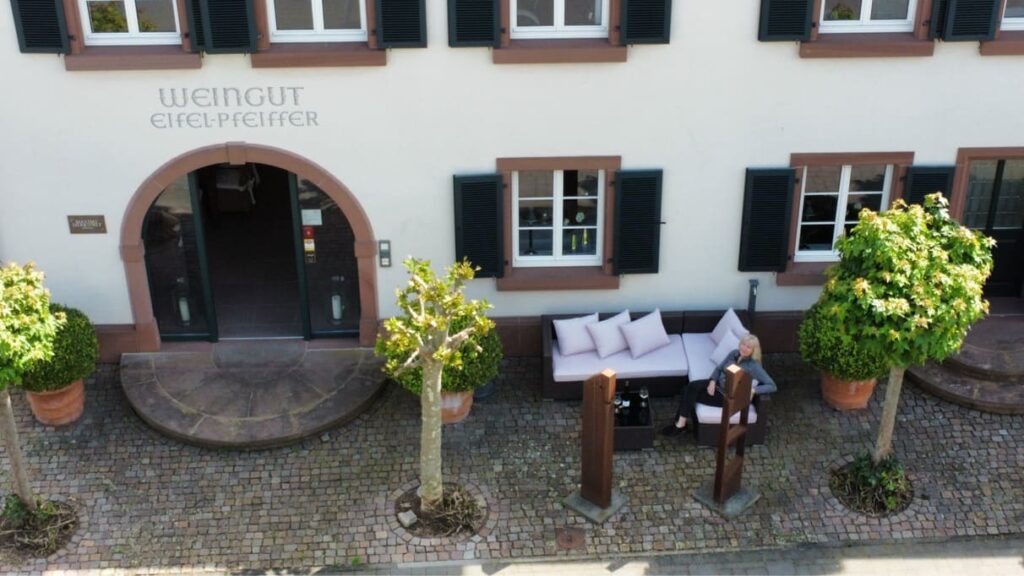
During the days we visited we had many opportunities to talk, but at our appointed time for our interview Raimund took us on a drive to the top of one of his vineyards, and it happened to be the oldest one that also is famous for its sundial. His tallest vineyards are 336 meters high, and the Mosel River is at 136. The ground is a combination of lush earth, wildflowers, and different types of slate rock – the rock in particular adds to the minerality found in the wines.
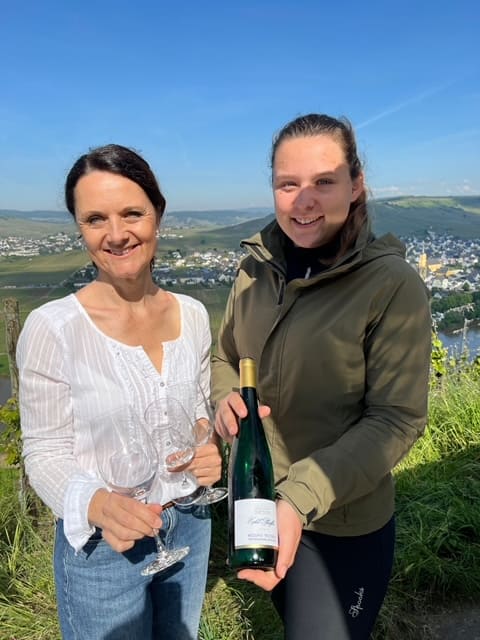
Eifel-Pfieffer: Did you know that award-winning Weingut Eifel-Pfeiffer has been in the same family since 1642, and is currently worked by three generations? We had a fabulous tour and tasting with mother and daughter Tanja Gorgen-Eifel and Mia-Katharina Gorgen.
We also learned that they only produce Riesling wines, have the coveted 1A rating which means that some of their vineyards are considered the best in the area, motivated Romanians work the steep vineyards, rainfall can’t always be counted on as it changes from year to year, and they have a total of 10 hectares over 30 kilometers in the Middle Mosel.
Their low-alcohol, not-overly-sweet, fresh, and mildly acidic wines are made from single vineyards – and also a blend of different vineyards that are only from the same area. Riesling “show character of each vineyard that you can really taste in the wine…the structure, minerality and acid” according to mother and daughter.
There are less winemakers now than there used to be: several of the smaller wineries have been absorbed by the larger ones as it’s been noted over time that it’s too cost prohibitive to run a small one-hectare winery.
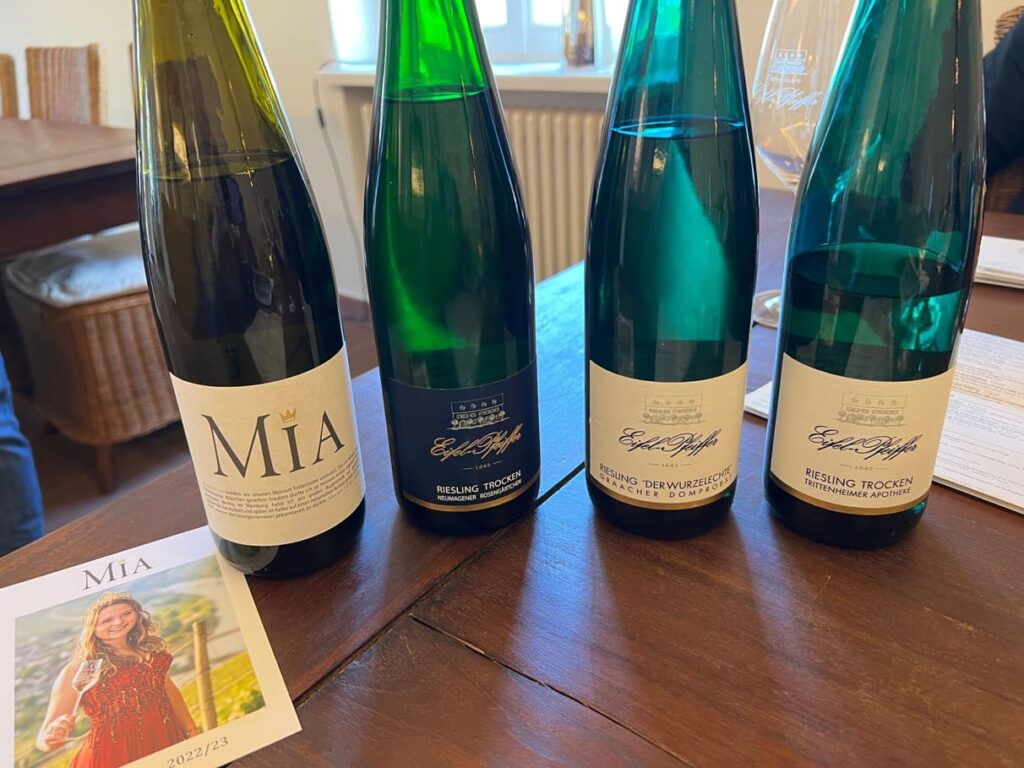
These Rieslings pair well with all types of food – German, Indian, Chinese to name a few – and China just might be the largest importer of Eifel-Pfieffer wines. I was super impressed with all of their wines, from dry to sweet, but must give a special nod to a 1990 vintage from Trittenheimer Apotheke and the 2021 Mia (made by Mia while she finishes up winemaking school) from Trittenheimer Altarchen.
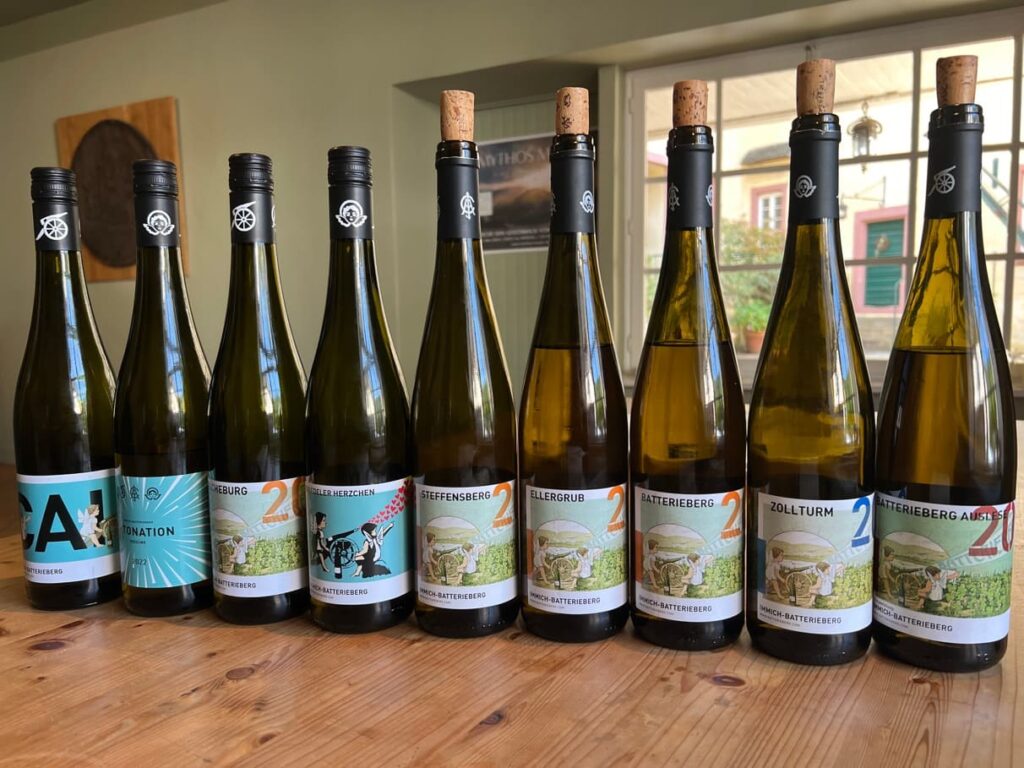
Immich-Batterieberg: This time we had the opportunity to sit down and taste with winemaker Gernot Kollmann while learning all about Immich Batterieberg. Let me just start by saying we liked every wine that Gernot opened for us. Most were very dry, all are organic, and 96% of the wines that they make are Rieslings.

What makes them special: they are the largest owner of old and ungrafted vineyards in the Mosel, all rocky and steep, and the winery dates back to 1425.
Seventy-eight percent of the 80k bottles they produce a year is exported to Japan, Italy, U.S., Switzerland, and the U.K. They receive top scores from Suckling and Parker, and those top-scoring wines sell out quickly.
The wines are a perfect example of the trend toward dry white wines (which means not sweet) and the continual production of lower alcohol wines.
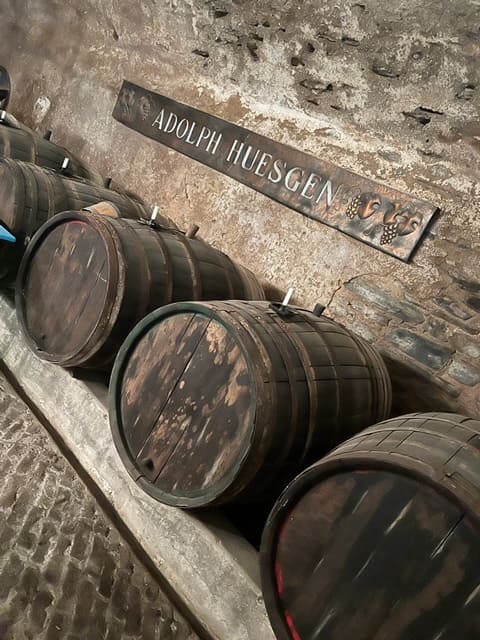
Villa Huesgen: If you are looking for a grand tasting experience, Villa Huesgen is it. Of course, if you have the opportunity to be charmed by Adolph Huesgen VIII himself, then it’s even more special. Adolph’s wine curriculum vitae is almost as interesting as the winery alone! He regaled us in stories of his many collaborations (from Australia to South Africa), work in wineries in California (he started his career at Robert Mondavi as the European sales director with Michael Mondavi) and what he and his family have currently achieved (sparkling, still, rose in the original blue bottles Riesling were first made in) at Villa Huesgen.

The Huesgen family established the vineyard nine generations before, in 1735. The art nouveau-styled estate was built in 1904. They grow Riesling and Burgundy grapes, currently have their first block of Chardonnay in barrels and make more dry than sweet wines. They import to 35 countries.

We tasted ten wines, one of which recently was listed as one of the top nine Rieslings in the world by the Robb Report April 2024. We would have a hard time not liking any Villa Huesgen wines.
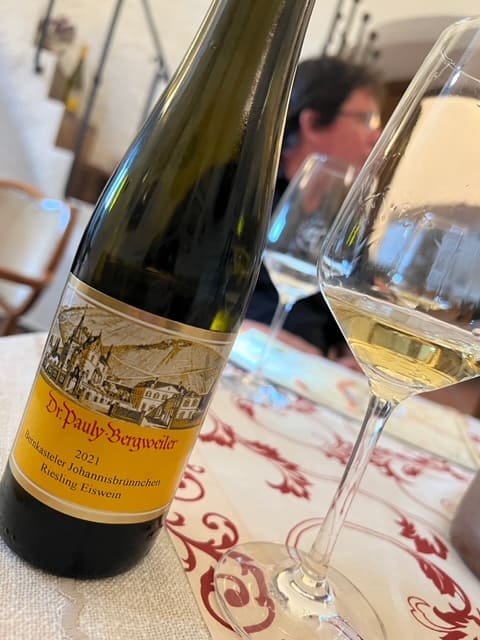
Dr. Pauly-Bergweiler: This estate is right in the popular part of Bernkastel-Kues, and just adds to the beautiful Mosel landscape. We were greeted by Stefan Pauly, who led us on a tour of the building and the many tasting areas for their guests. As this was the last tour of our trip, we “drank it up” for the history, and of course, the wines. We tasted many Rieslings, and even a beautifully made Eiswein, and were thrilled to discover that our local Total Wine stores has the exclusive label, Dr. Heidemanns-Bergweiler, and it’s very reasonably priced though it sells out every year. (Made a mental note to go there as soon as we get home!)
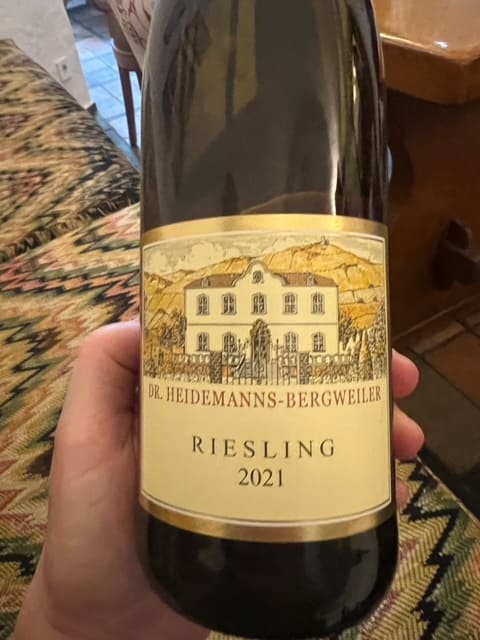
We learned that the winery was founded in 1556, they own 22 kilometers of vineyard along the Mosel, and they even offer an alcohol-free wine. One of the tasting areas we saw had a slight walkable ramp and was large enough to “seat a whole boat” of tourists that preferred not to climb up or down ancient steps for a wine tasting.
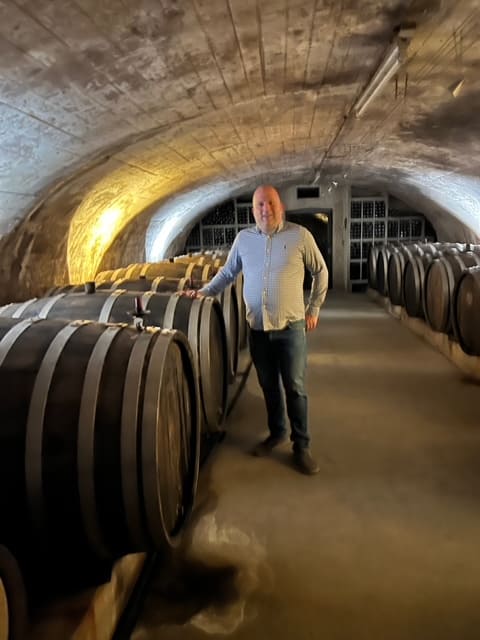
When to Visit
We happened to be in Bernkastel-Kues area of the Middle Mosel during Open Wine Cellar Days, which this year began on Germany’s Father’s Day. The holiday and the multi-day event brought many German tourists to the area, which added to the trip for us to “pick up some local color” so to speak. The event shows off many wineries not just during the day for tastings but also for night for tastings, meals, and live music. We chose to stay at the guest house at one winery, S.A. Preum, which made it even more convenient to walk over each night. We have been told that there are always wine festivals, so I highly recommend that you look at the calendar for these before planning your trip.
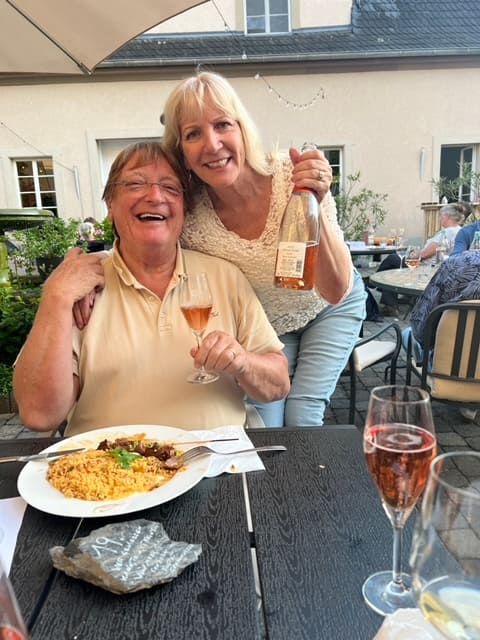
We got to Bernkastel-Kues from the Frankfurt airport, we rented a car and enjoyed the easy freeway routes and arrived just under two hours. We went in May, as we tend to pick times of the year when tourist areas are less crowded with summer travelers.

Besides wine tasting many tourists rent bicycles and e-bikes, tour on motorcycles, rowboat, parasail, take a boat tour and hike the vineyards. It’s a very walkable area in town with many wine bars, brew pubs, restaurants, and shops along the cobblestone streets. In other parts of the Mosel River, you can find sandy beaches and even water skiing.

There are many hotels along the Mosel River, we chose to stay in a suite at the Gastehaus at Prum and we would definitely return. Beautiful accommodations, locally sourced breakfast, and of course wine!
Find on Instagram: @VisitMosel @EifelPfieffer @ImmichBatterieberg @VillaHuesgen1735 @Weingut_PaulyBergweiler @S.A.Pruem
Eve Bushman has a Level Two Intermediate Certification from the Wine and Spirits Education Trust (WSET), a “certification in the first globally-recognized course” as an American Wine Specialist ® from the North American Sommelier Association (NASA), Level 1 Sake Award from WSET, was the subject of a 60-minute Wine Immersion video (over 16k views), authored “Wine Etiquette for Everyone” and has served as a judge for the Proof Awards, Cellarmasters, LA Wine Competition, Long Beach Grand Cru and the Global Wine Awards. You can email Eve@EveWine101.com to ask a question about wine or spirits.


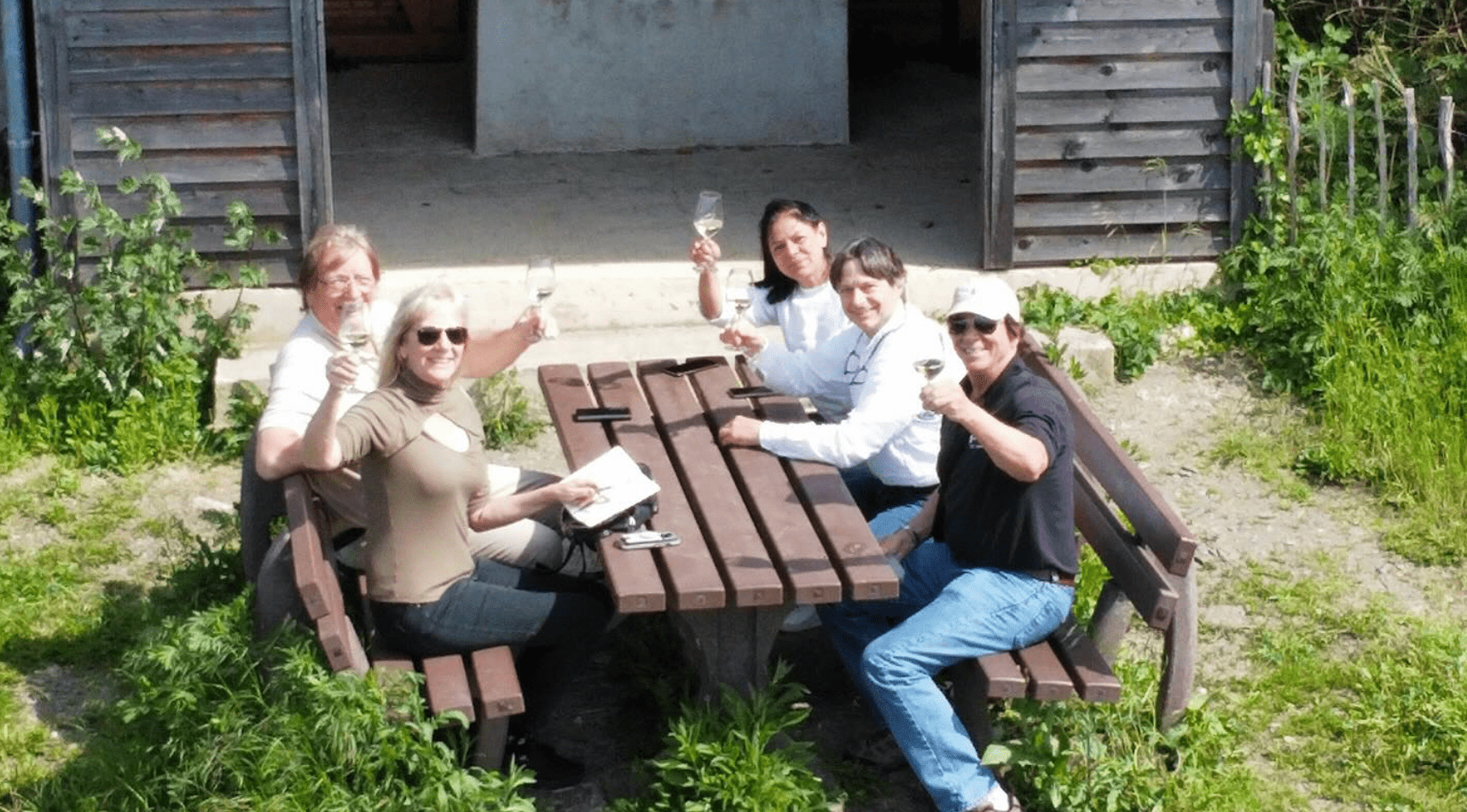

Wow! Geeat coverage. Love Rieslings
Very-very interested. I havent tried enough German wines